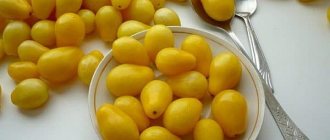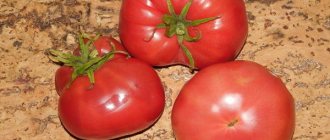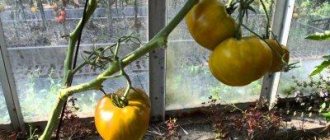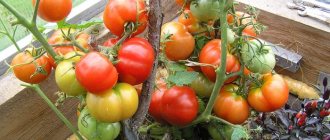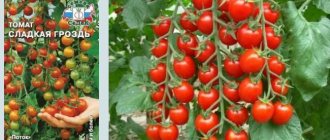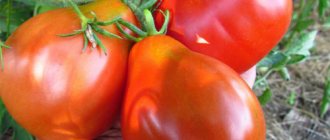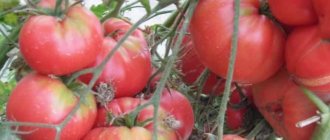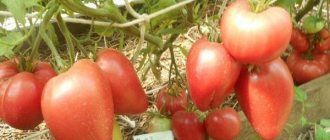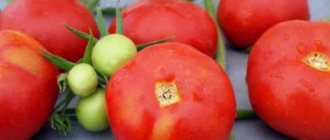Description of the variety
Fruit:
- They have an elongated oval shape;
- Fully ripe - bright yellow in color;
- With smooth, dense skin;
- With juicy sweet pulp;
The average weight varies from 30 to 40 grams.
- Number of seed chambers - 2-3;
- Dry matter content approximately 5%;
- Small sizes.
Bushes:
- Determinate type, weakly leafy;
- Medium height. Height varies from 80 to 100 cm;
- The leaves are large in size, dark emerald in color;
- Inflorescence of intermediate type. The first is formed over 8-9 leaves, the rest at intervals of 1-2 leaves;
- The peduncle has an articulation.
Checking the magnetron
If the microwave hums but does not heat, one of the reasons may be a malfunction of the magnetron. This lamp generates high-frequency radiation with a frequency of 0.5 - 10 GHz, which heats the contents of the chamber. A malfunction of the magnetron is often the reason why the microwave does not heat, but works, what to do.
If the contacts are not oxidized and everything is in order with soldering, you need to check the filament with an ohmmeter. Its resistance should be within 2 - 3 Ohms. If there is a break, the device will show infinity.
It should be taken into account that the housing and radiator of the magnetron heat up to 150°C during operation. Therefore, if the oven was turned on, for example, the transformer was checked, you need to wait for the lamp to cool completely. If after checking the oven does not heat the food, you need to replace the magnetron. To do this, you need to write down its technical characteristics, which are located on the back cover of the microwave or on the lamp, and contact a workshop. If you have the necessary skills, you can make the replacement yourself, but it is safer to invite a specialist.
Tomatoes: advantages and disadvantages
The tomato variety “Honey Candy” is popular among gardeners due to the following characteristics:
- High taste qualities;
- Good yield;
- Immunity to diseases typical of tomatoes;
- Resistance to temperature fluctuations;
- Ability for long-term storage;
- Possibility of transportation over long distances;
- Good external qualities of fruits;
- No tendency to crack;
- Possibility of cultivation in unprotected soil and greenhouse structures.
Among the disadvantages of “Honey Candy” are:
- Increased requirements for care at the stage of crop growth;
- Sensitivity to watering, lighting and applied fertilizers.
Hybrid cherry tomatoes
And although Honey Candy appeared on the tomato market relatively recently, it is already in great demand among vegetable growers in different regions of our country. It is especially appreciated in large farms that specialize in growing tomatoes for sale.
The description of the variety should begin with the timing of fruit ripening. From the moment the first seedlings appear until the tomatoes fully ripen, it takes about 3.5 months, so this hybrid is classified as a mid-early variety.
In the southern regions and the Volga region, this variety is grown in open ground, but in the middle zone and regions with a similar climate it is better to grow Honey Candy in greenhouse conditions or under film. The bushes of this vegetable belong to the determinate type, so they do not grow in height above 0.9-1.0 m. The shoots are erect, powerful, weakly branched.
Honey Candy f1 can be grown in garden beds; it is also perfect for planting in greenhouses. The hybrid has average resistance to diseases that usually affect tomatoes. Due to the fact that the fruit ripens quite early (in mid-late July), Honey Candy is practically not affected by late blight.
The shoots are slightly leafy, the foliage is large, dark emerald in color. The inflorescences are arranged alternately with the foliage. This hybrid is classified as Cherry, so each cluster usually ripens 15-27 small fruits. In total, no more than 6 brushes are formed on one shoot. It is best to form each bush with no more than 3 stems to achieve better ripening of the crop.
The color of ripe fruits is yellow with an orange tint. Their weight is about 25 grams, the taste of ripe fruits is excellent. The productivity of the Honey Candy tomato is quite high - up to 6 kg per 1 m². Moreover, in greenhouses from this hybrid the amount of harvested crop is higher than in open ground.
I noticed that cherry tomatoes, unlike large-fruited tomatoes, even in open ground form several clusters, and on each cluster beautiful, neat tomatoes hang. Moreover, now there are many wonderful hybrids of the so-called cocktail type with fruits that are not so small - weighing up to 70 g.
These wonderful tomatoes are great for salads and preparations. And fresh, these tomatoes are simply amazing! I especially liked three hybrids:
- Raspberry Farmer F1
- Children's sweets F1
- Honey candy F1
This medium-early ripening hybrid, determinate type, forms low bushes up to 70 cm. I formed it into 3-4 stems, and they bore many clusters with fruits weighing up to 60 g. The tomatoes are round, red-crimson in color. The description of the variety states resistance to temperature changes, which is very important when growing in our climate and in open ground. In general, these tomatoes pleased me with their yield and sweet taste. They grew well in the beds until the frost.
Honey candy F1
Determinate, the height of plants in open ground is no more than 80 cm. I pinched and tied up the plants. Many clusters were formed, abundantly hung with medium-sized (30–40 g) oval-shaped, yellow fruits. They turned out to be very sweet. The variety is resistant to diseases and hardy in our difficult climate. I will definitely continue to grow these hybrids!
Growing tomatoes
Like most tomato crops, the Honey Candy variety is cultivated by seedlings.
How to prepare seeds?
Since at the genetic level the tomato variety “Honey Candy” has excellent immunity, the seed material does not require pre-treatment before sowing.
Sowing seed material
Description:
- Forcing seedlings begins in the last ten days of March - the first ten days of April;
- Seed material is sown in special soil for tomato crops;
- Seeds are planted to a depth of 1-1.5 cm in moist soil;
- After the formation of a pair of full-fledged leaves, the seedlings are planted in separate containers and also fertilized with mineral complexes;
- Throughout their growth, seedlings are provided with timely watering, sufficient daylight and the required temperature conditions.
Rules for planting seedlings
Description:
- Seedlings that have reached the age of 55-60 days can be planted in a permanent place. Planting in a greenhouse structure begins in the last days of May, in unprotected soil - in the first ten days of June;
- To grow the variety, it is optimal to choose the sunniest areas;
- When planting, maintain a density of no more than 4 tomato bushes per 1 m2. The interval between planting holes should be 40 cm, the row spacing should be at least 60 cm.
Planting a plant in the ground
Due to the fact that the plants already have excellent immunity, the seeds do not need to be pre-treated before growing the plants. In addition, you can plant them immediately in earthen boxes without prior preparation. The plant is planted before spring, only after the last frost has gone.
If the “planting” will be done in open ground, then it must also be prepared. First, you can’t plant tomatoes in the same place where they were already before; change the soil in places. And before planting the plant, treat the soil against insects and diseases, and then fertilize it with humus or your proven preparation.
I live in a risky farming zone - in Siberia, and I grow tomatoes in open ground. And this leaves its mark on the nature of their cultivation.
Of course, large-fruited, fleshy tomatoes are good. But in open ground, and even in unfavorable summer conditions, they very often do not show all their qualities. One good first bunch will form with several large fruits, on the second the fruits are no longer so large, and they are smaller in size, and that’s all.
Therefore, for some time now I began to grow cherry tomatoes and am very pleased with the result.
Cherry tomatoes include varieties of tomatoes whose fruit weight does not exceed 25 g. These are very tasty tomatoes, suitable for salads, pickling, whole-fruit canning, and especially for table decoration.
Bush care
After planting, tomato bushes need the following care:
- Regular watering. The soil should not dry out; during a long dry period, the amount of watering is increased;
- Mandatory garter. Since the branches are rich in fruits, the bush must be tied to trellises or other reliable trellises;
- Forming a bush. Grow the plant in 5-6 stems, removing the remaining stepsons;
- Throughout the entire growing season, 3-4 feedings are carried out using mineral complexes.
Features of agricultural technology
Tomatoes are unpretentious and produce high yields if you follow simple growing rules.
Attention! Sowing begins in early March. After 50-55 days, the seedlings are transplanted into the ground. The determinate hybrid grows up to 80 cm
But despite its small growth, due to the heaviness of the crop, the stem requires additional support. Secure the plant to prevent the trunk from breaking. It is strongly recommended to plant bushes. Do not forget about fertilizing 2-3 times per season. Universal mineral supplements are suitable
The determinate hybrid grows up to 80 cm. But despite its small growth, due to the severity of the harvest, the stem requires additional support. Secure the plant to prevent the trunk from breaking. It is strongly recommended to plant bushes. Do not forget about fertilizing 2-3 times per season. Universal mineral supplements are suitable.
The fruits quickly gain weight. The peel does not always keep up with the growth rate, so it may crack. To avoid this, do not leave a long interval between waterings. Use settled water and water in small portions. The soil should not have time to dry out.
It is preferable to plant tomatoes in open ground. Planting in a greenhouse with frequent ventilation is allowed.
Productivity
The tomato has a good yield for its size. If you properly care for the variety and follow the recommended planting scheme, from 1 m2 you can harvest from 8 to 12 kg of bright yellow tomatoes.
Which regions are best to grow in?
In unprotected soil, the Honey Candy tomato is grown in the southern regions of the Russian Federation - in the Krasnodar Territory, in the North Caucasus or in the Crimea. The use of film shelters is optimal for growing in the middle zone. In more northern regions, it is advisable to use greenhouse structures with a heating system for cultivation.
Disease Prevention
The “Honey Candy” variety of cherry tomatoes is no different in its characteristics from large fruits. The immunity of this bush is very good, so it is rarely affected by any diseases.
It tolerates various diseases common in tomatoes well. Resists attacks by aphids, Colorado potato beetles and slugs. Nevertheless, timely treatment against diseases and pests is still necessary.
- (otherwise the gardener sees withered and yellowed leaves - this could be Phoma, in which case it is advisable to remove the leaves to avoid disease of the entire bush. It is necessary to constantly treat the plants with the preparation "Hom". You should also reduce the amount of nitrogen fertilizers and increase the amount of watering.
- Dry spotting is possible. To prevent it and spread to all plants, the bushes are treated with Antrakol, Consento and Tattu.
- It is plausible, but not frequent, that this tomato is attacked by slugs and mole crickets. A solution of hot pepper and mustard works well against slugs. Use 1 cone of dry mixture per 1 square meter.
- It is more difficult to fight a mole cricket. To achieve this, the soil should be weeded, loosened and mulched. It is also appropriate to use the drug “Gnome”.
- In a greenhouse, a plant may be susceptible to invasion by small whitefly butterflies. To counter this insect, use the drug “Confidor”. Manufacturers indicate the correct dilution of each drug in the packaging.
They note good productivity of tomatoes, as well as a long period of storage of fruits before harvesting.
The Honey Candy tomato is an excellent variety for professionals and amateurs alike. By following the rules of care, processing, glazing and feeding, everyone can achieve the ripening of a good and tasty harvest.
Reviews about the variety from those who planted
The tomato variety “Honey Candy” has caught the taste of Russian gardeners. They appreciated the size and color of the tomatoes, which they conquered with their stable yield and high shelf life of the collected tomato fruits.
Thanks to its unpretentiousness, even a novice vegetable grower can cope with growing the “Honey Candy” tomato variety. To add a little variety, it is worth planting several “Honey Candy” tomato bushes in your garden plot.
The best varieties and their features:
Description and characteristics of the tomato Honey Candy F1, reviews, photos
Mid-early (110-115 days from germination to ripening), determinate, cluster hybrid of cherry tomato. In the middle zone, it is recommended to grow it in a greenhouse or under film covers.
Slightly leafy bush, 0.8-1 meter high. The leaf is large, dark green in color. The inflorescence is intermediate. On the main stem, 5-6 clusters are formed with 14-28 fruits in each. The bush requires tying to a support and pinching. The best results were obtained when forming a plant with 2 or 3 stems.
